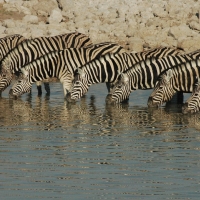 “A highlight of our trip through Africa”, we can certainly say that about our visit to Etosha National Park. The game park is situated in the north-west of Namibia and is one of the largest game parks in southern Africa. With an area of 22,270 km2 it is greater than half of the Netherlands! The park is home to a large number of different animals: large groups of elephants, rhinos, zebras, all kinds of antelopes and many birds. The park consists of dry savannah, with a huge salt pan in the center and a large number of waterholes throughout the park. The animals all come to the waterholes to drink, making it the perfect place to see the wildlife.
“A highlight of our trip through Africa”, we can certainly say that about our visit to Etosha National Park. The game park is situated in the north-west of Namibia and is one of the largest game parks in southern Africa. With an area of 22,270 km2 it is greater than half of the Netherlands! The park is home to a large number of different animals: large groups of elephants, rhinos, zebras, all kinds of antelopes and many birds. The park consists of dry savannah, with a huge salt pan in the center and a large number of waterholes throughout the park. The animals all come to the waterholes to drink, making it the perfect place to see the wildlife.
We have reserved five days for Etosha and will camp four nights in the park. Peter and I are not allowed to drive through the park on the motorbikes, so the next few days we ride with Dick in his car. For these occasions he had rented a bigger car with more seats! We can leave the motorbikes at a lodge just outside the park at a secured parking.
 For the first two nights we booked a camping spot at Okaukeujo Rest Camp. It is an enclosed area with a hotel, a campsite, a shop, a restaurant and even a swimming pool. Just behind the fence is a waterhole where animals come to drink throughout the day. Next to the waterhole a terrace has been built with benches that provide a view over the waterhole. From the campsite we can walk on our flip-flops to the waterhole to watch the wildlife without fear that we are being attacked by a lion.
For the first two nights we booked a camping spot at Okaukeujo Rest Camp. It is an enclosed area with a hotel, a campsite, a shop, a restaurant and even a swimming pool. Just behind the fence is a waterhole where animals come to drink throughout the day. Next to the waterhole a terrace has been built with benches that provide a view over the waterhole. From the campsite we can walk on our flip-flops to the waterhole to watch the wildlife without fear that we are being attacked by a lion.
The first time we take a seat on one of the benches there are no animals at the waterhole. But we do not have to wait long before the first elephant shows up. He slowly walks to the water and starts to drink. When he has had enough, the elephant empties his trunk over his back for some refreshment. In the distance we see the first giraffes approach. They are shy and very cautious. Only when they feel confident enough they put their front legs wide apart to reach the water with their long necks.  After the giraffes a group of springbok and a group of oryx appears. They all patiently wait their turn and only if there is enough space they come to drink some water.
After the giraffes a group of springbok and a group of oryx appears. They all patiently wait their turn and only if there is enough space they come to drink some water.
As quickly as they make their way to the water, just as quickly are they gone again, leaving the waterhole deserted. But that is no reason for us to leave. You never know what animals will come around the corner next. We patiently wait and during the day many different animals visit the waterhole. We only go back to the campsite to get some food or some new batteries for our cameras. It results in some beautiful pictures, especially in the light of the setting sun.
When the sun has set we can just stay at the waterhole, because it is lit all night! While we search the area for some movement, everyone around us starts to whisper: “Lions!” Two young lions are running to the water. They have the place to themselves because all the other animals had smelled the lions from afar and had wisely left the waterhole. As if they are house cats drinking milk out of their bowl, they sit next to the water drinking with their outstretched tongues. 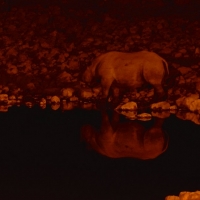 It is impressive to see these big cats from so close. Not much later, while the lions are still at the water, two rhinos come to the waterhole. They seem to take no notice of the lions, nor of the many tourists behind the fence. Late that night, when the lions and rhinos have left and we can hardly keep our eyes open, we crawl into our tents.
It is impressive to see these big cats from so close. Not much later, while the lions are still at the water, two rhinos come to the waterhole. They seem to take no notice of the lions, nor of the many tourists behind the fence. Late that night, when the lions and rhinos have left and we can hardly keep our eyes open, we crawl into our tents.
The next morning we are already back at the waterhole before breakfast. It is quiet and there are almost no animals. Just a few little deer and some jackals. When we come back after breakfast the waterhole looks completely different. It is busy and we count over 250 springbok. After they have spent some time drinking, a huge group of zebras and wildebeest walks to the water. We count more than 100 zebra’s and 200 wildebeest. It is amazing to see such great numbers of animals together. All morning game keeps coming to the waterhole: kudu, giraffe, zebra, wildebeest and springbok. Really great!
 We drag ourselves away from the water to get into the car for a ride through the park. We drive across the vast gravel roads to several other waterholes and see many animals along the way. This time we also see a lot of birds that do not visit the waterhole at Okaukeujo like ostriches, secretary birds and kori bustards. The most special is the view over the salt pan. In one glance we see giraffes, wildebeest, zebra, oryx, springbok and ostriches. They all gather around the water, walking right next to each other, looking for some refreshment. Just like Noah’s Ark.
We drag ourselves away from the water to get into the car for a ride through the park. We drive across the vast gravel roads to several other waterholes and see many animals along the way. This time we also see a lot of birds that do not visit the waterhole at Okaukeujo like ostriches, secretary birds and kori bustards. The most special is the view over the salt pan. In one glance we see giraffes, wildebeest, zebra, oryx, springbok and ostriches. They all gather around the water, walking right next to each other, looking for some refreshment. Just like Noah’s Ark.
After two nights at the campsite of Okaukeujo and many hours at the waterhole, we pack our tents to move to Halali Rest Camp. That is also a fenced area where we can safely camp. It is only 70km away, but we use the whole day to get there and to stop at various waterholes on the way. As with Okaukeujo the waterholes are sometimes deserted and you have to wait a while before the animals show up. We park the car in a good spot and wait until the game comes out from the bushes. This time we do not watch them from a bench, but from the car. Now we are no longer at the fenced campsites it is too dangerous to just step out of the car. You never know what is hiding in the bushes.
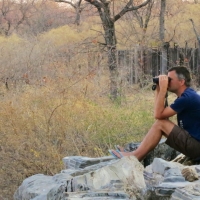 We search with the binoculars for some movement. Some animals are immediately recognizable by their long necks or flapping ears, but for the small deer and other animals -especially birds- we have to look in one of the books to find their names. We keep a list of all the animals we have seen and after two days that is already quite long. There are so many more animals to see than just the ‘Big Five’. At the end of the day we pitch our tents at Halali and place our ’boerewors’ on the braai (BBQ), just like all our South African neighbours.
We search with the binoculars for some movement. Some animals are immediately recognizable by their long necks or flapping ears, but for the small deer and other animals -especially birds- we have to look in one of the books to find their names. We keep a list of all the animals we have seen and after two days that is already quite long. There are so many more animals to see than just the ‘Big Five’. At the end of the day we pitch our tents at Halali and place our ’boerewors’ on the braai (BBQ), just like all our South African neighbours.
There is a waterhole at Halali as well, where we can go from the campsite. When we arrive there the next morning, there seem to be no animals. Only with the binoculars we see that there is a huge lion lying in the bushes. No wonder there are no deer at the waterfront! The lions is almost invisible to the bare eye because the colour of his fur blends in so well. With the binoculars however we can almost count his whiskers. As one of the tourists beside us sneezes, the lion turns his head in our direction and looks -almost arrogantly- up to the group of tourists who are looking at it. He apparently does not like the noise of clicking cameras because not long after that he stands up and disappears into the bushes. What a beast!
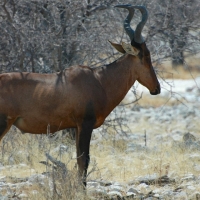 From Halali we also make a roundtrip. We have prepared for a long day in the car, with a thermos of coffee, cookies, sandwiches and plenty of water. The three of us ride from waterhole to waterhole, where we stay for a while to wait for the animals to show. We see animals that we had not seen before in other parts of the park, such as a hartebeest and the black-faced impala. Today it is mainly the day of the elephants. Along the way we see a large group of up to 18 elephants, with several young. They stopped at some trees and pull the branches from the trees to eat. The trees shake from side to side until the branch breaks with a loud crack.
From Halali we also make a roundtrip. We have prepared for a long day in the car, with a thermos of coffee, cookies, sandwiches and plenty of water. The three of us ride from waterhole to waterhole, where we stay for a while to wait for the animals to show. We see animals that we had not seen before in other parts of the park, such as a hartebeest and the black-faced impala. Today it is mainly the day of the elephants. Along the way we see a large group of up to 18 elephants, with several young. They stopped at some trees and pull the branches from the trees to eat. The trees shake from side to side until the branch breaks with a loud crack.  All the trees in the area seem to have been visited by the elephants, because they all miss a few branches.
All the trees in the area seem to have been visited by the elephants, because they all miss a few branches.
We visit another waterhole where we see an even larger group of up to 30 elephants. They drink by filling their trunks with water and spraying it in their mouths. Once they have drunk enough, they throw the water on themselves to cool off. Their backs, their heads, their belly, there is no place that stays dry. Other elephants have found a faster way and just lay down in the water to cool off. They hold their trunk above the water to breathe. When the eldest elephant decides it is enough and prepares to move on, the other elephants stand up as well and follow their leader. The group of wet elephants crosses the road right in front of our car, while the biggest elephant remains on the road like a traffic controller to stop the cars. Just when we prepare to leave the waterhole, another group of elephants approaches. This time we count more than 40 animals. And so the whole spectacular bathing ritual begins all over again. Fantastic!
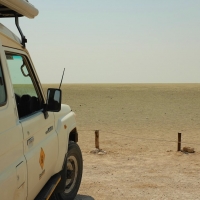 During our tour we also stop on the salt flat at the lookout point that was made there. The sunlight reflects at the white ground and while we drive to the pan it is getting warmer and warmer. Once on the salt flats, the thermometer shows a temperature far above the 40ºC. The large plain stretches before us, it is hard to imagine how far we can see. It is the only place in the park where we can get out of the car. On the open plains we should be able to see predators from afar, (hopefully) in time to get back into the car. We walk on the dry pan, take some pictures and then quickly get back in the car. Not because of the animals, but especially because of the scorching sun.
During our tour we also stop on the salt flat at the lookout point that was made there. The sunlight reflects at the white ground and while we drive to the pan it is getting warmer and warmer. Once on the salt flats, the thermometer shows a temperature far above the 40ºC. The large plain stretches before us, it is hard to imagine how far we can see. It is the only place in the park where we can get out of the car. On the open plains we should be able to see predators from afar, (hopefully) in time to get back into the car. We walk on the dry pan, take some pictures and then quickly get back in the car. Not because of the animals, but especially because of the scorching sun.
After a final warm night at the campsite in Halali we fold the tents and we get in the car early that morning. At 14:00 we have to leave the park and we want to spend all the remaining time in the park. We visit some other waterholes and are treated to a desert on our last day.  On our way to the last waterhole, we see a huge rhino next to the road. He has just been at the waterhole and is covered in white mud. What an impressive beast, just like a dinosaur. Once at the waterhole, it is particularly busy around the water. There are giraffes, zebras, springbok, oryx and ostriches. And as icing on the cake, there is a huge group of elephants bathing. Wet from the water, they throw sand over their back with their trunks, covering themselves with a thick layer of white dust. Beautiful!
On our way to the last waterhole, we see a huge rhino next to the road. He has just been at the waterhole and is covered in white mud. What an impressive beast, just like a dinosaur. Once at the waterhole, it is particularly busy around the water. There are giraffes, zebras, springbok, oryx and ostriches. And as icing on the cake, there is a huge group of elephants bathing. Wet from the water, they throw sand over their back with their trunks, covering themselves with a thick layer of white dust. Beautiful!
We stay as long as possible to watch the elephants until we really need to ride to the exit of the park and back to the motorbikes. We had five great days! We had already been on safari, but this was the first time we saw such large numbers of animals together. I could have easily spend another week sitting on a bench near the waterhole in Okaukeujo. It was very special!
 The three of us took over 1350 pictures with our four cameras! A lot, especially when you consider that we very often put the cameras away to simply look. Click here to see a small selection of all those photos (we did put in some extra pictures this time).
The three of us took over 1350 pictures with our four cameras! A lot, especially when you consider that we very often put the cameras away to simply look. Click here to see a small selection of all those photos (we did put in some extra pictures this time).
Distance to Etosha National Park: 29 003 km (18.022 miles)
Previous story “Land of extremes” – Next story “Three times ‘water’“





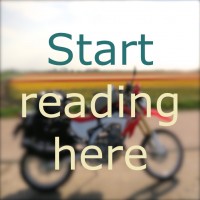


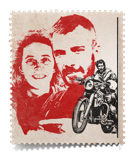
Ha die Leonie en natuurlijk Peter en Dick.
Wat zien en beleven jullie toch veel. En wat ik helemaal geweldig vind, dat Dick een gedeelte van jullie wereldreis mee mag en kan maken. Wat zal hij genieten, supergaaf.
Lieve mensen, geniet met volle teugen, ik volg de volgende verhalen graag.
Lieve Barneveldse groet, Niny.
Wat ziet dat er Heer-luk uit, die rollende en slurpende olifanten!
Genieten!
xxx
Wat een heerlijk verhaal!Weer een stukje van je bestseller!! Liefs van ons xxx
Wat gaaf zeg! Mooie plaatjes. Vooral de zebra’s zijn zeer fotogeniek!
geweldig wat een belevenis mooie foto,s gr jannig
PRACHTIG, daar wil ik ook heen!
Wat een prachtige foto’s!
Had graag bij jullie opt bankje gezeten!!
Geweldig!
Zo mega indrukwekkend! Al die dieren bij elkaar, zo in harmonie.